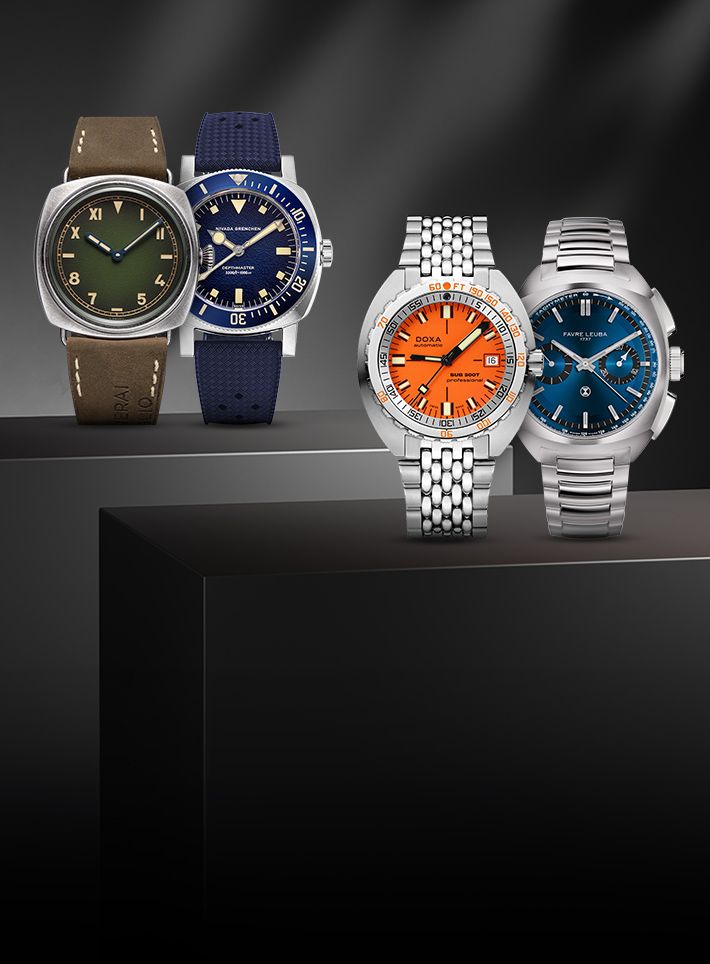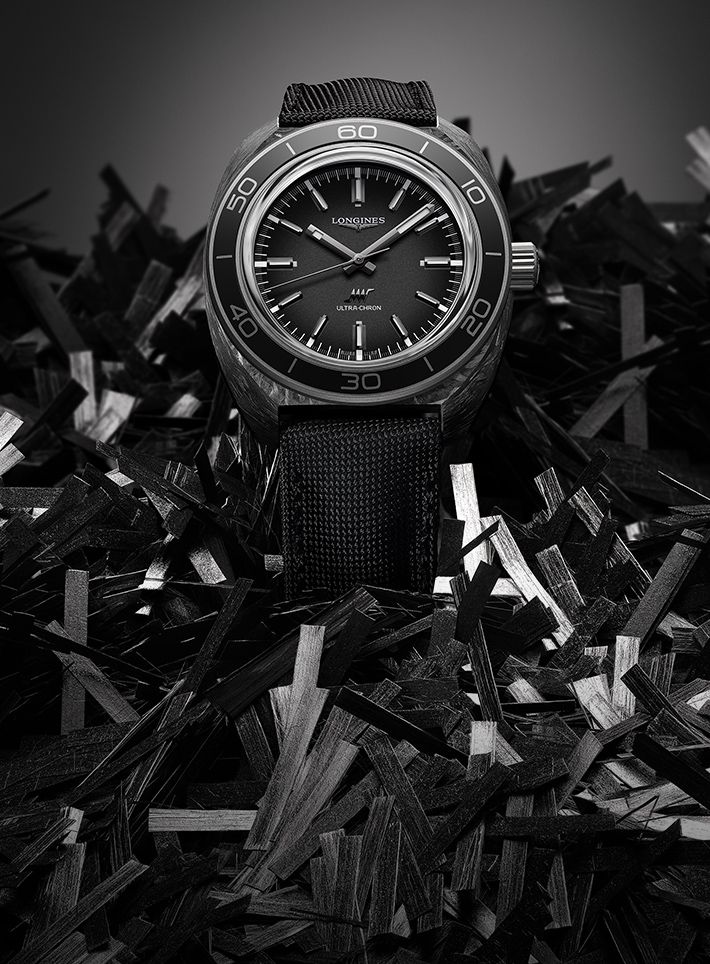FeatureCelebrating 55 Years Since Humankind Set Foot On The Moon, With The Omega Speedmaster—Moonwatch And Others
Marking 55 years one of the most storied horological landmarks of our times, we revisit how the Omega Speedmaster became the Moonwatch and the influence it has had on other Speedmasters among the brand’s offerings
May We Recommend
Omega’s Speedmaster Professional will forever be the Moonwatch. It earned this stripe 55 years ago on July 21, 1969, when Edwin ‘Buzz’ Aldrin became the second man to walk on the lunar surface and did so with a Speedmaster strapped to his spacesuit. Half a century on, today’s Moonwatch looks virtually indistinguishable and still connects you to one of mankind’s greatest achievements. And while the classic, original Speedmaster Professional is irreplaceable, the Speedmaster line has also become Omega’s canvas to pay tribute to and celebrate our mystical exploration of space.
As a side note, you will notice that only a watch enthusiast can tell the story of humankind’s first steps on the moon without so much as mentioning a certain Mr Armstrong. The reason for this is that Neil Armstrong left his watch behind in the lunar module.
How Speedmaster Became The Chosen One
The oft-repeated story goes something like this. NASA (USA’s National Aeronautics And Space Administration) started searching for a watch in 1964 that would accompany astronauts on space missions and be a backup timer—part of their standard issue equipment. Letters were written to American distributors of leading manufacturers with the required specifications, and some brands then submitted their watches. Three were shortlisted for testing, to be put through 11 extreme tests, including temperature, pressure, humidity, shock and vibration tests. Only the Omega Speedmaster passed all 11 tests and in 1965, was flight-qualified by NASA for all manned space missions. The caseback of the classic Moonwatch bears this inscription even today.
The watch Omega submitted to NASA is visually very similar to the Moonwatch’s current avatar and what’s admirable is that no modifications were made prior to submission. The watch tested by NASA was the watch you could pick up off the shelf at any store at the time. These kinds of horological triumphs reinforce the romanticism of a mechanical wristwatch even in our extremely electronic times.
What many don’t know is that it was the Speedmaster chronograph which was used at a critical, life-threatening moment of the aborted Apollo 13 mission. It was when Mission Commander Jim Lovell told NASA, “Uh, Houston, we’ve had a problem.” After an oxygen tank exploded on board, the crew of three astronauts had to use the lunar module to re-enter Earth’s atmosphere. And to manually adjust the course of the module, they needed to time a 14-second fuel-burn so that it wouldn’t bounce back into space. The crew was saving all the power they could, so almost all systems inside the spacecraft had been shut down. Timing this burn fell on the Omega Speedmaster and the crew returned to earth safely against the odds. I don’t recall another wristwatch story that has given me such goosebumps. Going beyond just accurate timing, the Omega Speedmaster has even helped save lives.
Omega In Outer Space—Before NASA’s Qualification
The moon landing in 1969 wasn’t the Speedmaster’s first tryst with extraterrestrial travel. Astronaut Wally Schirra’s personal Omega accompanied him on Sigma 7 in October 1962, before NASA began its official search—an almost poetic foretell. Until this time, the Speedmaster was still a few design iterations away from the watch that we recognise it as today. The dial didn’t have the ‘Professional’ marking and the pronounced crown guards on the case were absent. It also had straight lugs, Alpha hands, and was designated as reference CK2998.
It is because of this special association that the first Omega in space was reissued by Omega in 2012, with the CK2998’s aesthetic signatures intact, down to the smaller 39.7mm case size. Even without the centrally-mounted, teardrop chronograph seconds counter, the first Omega in space is unmistakably a Speedmaster with a healthy dose of vintage charm.
The Timeless Original Moonwatch
The Moonwatch Omega makes today has remained more or less unchanged since 1968. Purely from a design standpoint, no other sports watch can boast 50 years of design continuity like the Speedmaster can. Its look is so distinguished and iconic that you can spot one from across the room. Yet it shows no signs of age because of how harmonious and complete the design is. Legibility is off the charts, case-work is fairly complex and dial symmetry is brilliant.
To Omega’s credit , they have done well to preserve the little things that have come to define the watch, such as the acrylic hesalite crystal glass and manual-winding chronograph movement. While Omega have also made a version with a domed sapphire crystal glass that does a good job of marrying vintage cues with modern practicality, a purist’s heart tends to side with the unaltered original. In its own way, this model is peerless, and it’s really no surprise that Omega have tinkered so little with it.
The Modern Take
Omega went into round two of developing a watch for space travel in the 90s, as we readied for a Mars mission. Along with NASA, ESA (the European Space Agency) and fighter pilots of the American armed forces, they developed a 45mm watch in titanium called the X-33. Its key highlight is the LCD with digital functions, combined with an analogue time display. Launched in 1998, the X-33 became the second NASA-qualified watch for space missions.
In its current guise as the Skywalker, the X-33 incorporates features such as mission elapsed time, a deafeningly loud alarm, three time zone tracking and something known as phase elapsed time (PET), developed and patented by ESA astronaut Jean-François Clervoy. PET is essentially the ability to set a notification or alarm for a future event by inputting the start time and duration without having to calculate the end time. This has real utility for astronauts, which is why Clervoy worked on a novel, implementable solution. The Omega Skywalker X-33 is space-flown and is the Moonwatch of the 21st century, so to speak.
Accompanying the Skywalker X-33 in the ana-digi range of the Speedmaster is the Spacemaster Z-33. The Spacemaster has its roots in Omega’s Flightmaster from 1969, whose distinctive helmet-shaped case was brought back after a long hiatus. One look at the Z-33 and the first thing that comes to mind is that it’s truly space-age, so the Spacemaster moniker is well chosen. It is easily the chunkiest watch in Omega’s repertoire, but its sheer futuristic appeal is undeniable. Apart from features such as a chronograph, perpetual calendar, three time zone tracking and a countdown timer, the quartz movement enables the watch to record logs of up to ten flights, making it a true pilot’s watch. The Spacemaster Z-33 isn’t a Moonwatch, but a close spiritual cousin. This is innovative Omega at its best.
The Moon—A Perpetual Muse
Alongside Speedmasters with hard-core space credentials exists another facet to the Moonwatch—one that is more whimsical and celebratory, to create timepieces inspired by our enchantment with the moon. It is an extension of the story started by Buzz Aldrin’s watch in commemoration of a tremendous human feat.
Special edition Speedmaster watches go all the way back to the 1960s, but in recent times, the most highly acclaimed Speedmaster is probably the Dark Side Of The Moon, released in 2013. This watch pays tribute to Apollo 8, whose crew was the first to see the dark side of the moon. The Dark Side Of The Moon is striking and outright modern, conveying the ‘darkness’ by using black ceramic for all key components, including the case, crown, pushers and even the dial. Usage of ceramic to this extent on a wristwatch is rather uncommon and shows Omega’s technological and machining prowess.
The success of the Dark Side Of The Moon has led to it becoming a sub-collection itself, with common features such as a 44.25mm case size, a self-winding co-axial movement, a two-register dial layout and the use of ceramic for the case, crown and pushers, in a larger number of watches. One of these is set in a grey ceramic case with a meteorite dial, using Sedna gold (Omega’s proprietary rose gold alloy) for the bezel, hands and indices, which provides warmth and contrast against the dark grey dial. Now the meteorite dial isn’t an artistic treatment to achieve a certain effect, but an actual piece of meteorite treated with nitric acid to reveal a unique pattern due to its internal structure. Notwithstanding its full ceramic casing, the dial is the star here (pun completely intended).
Omega also brought the Master Chronometer certification to the Speedmaster through a special watch—one with a moon phase indicator, chronograph and ceramic Liquidmetal bezel. I’m sure the moon phase symbolism isn’t lost on you, but this isn’t just any depiction of the moon. It is an amazingly detailed moon for something so small in size. And if you look a little closer, Omega has secretly added a little quirk by reproducing Buzz Aldrin’s famous footprint on the moon. I find this to be a marvellous touch, which truly elevates this watch for any space travel fan. I’m sure Omega felt it was onto something with that footprint, and it wasn’t the last we would see of it.
The Apollo 11 50th Anniversary Editions
While we discussed a brief history of the Moonwatch, we’re now back to where we began—the 50th anniversary of the moon landing. It’s certainly a grand occasion and what the brand would do to mark this milestone had been a topic of much discussion and speculation since last year. Now that the wraps are off, I am happy to say that the anniversary editions are loaded with Omega DNA—honouring history, keeping an eye on the future, and making special watches accessible to collectors (relatively speaking, of course).
Omega decided to release two anniversary editions to celebrate 50 years of Apollo 11. Unsurprisingly, one was an all-gold, while the other was in steel. Both pay rich tribute to the red-letter day in different ways, but are forward-looking, in true Omega style. The headliner anniversary piece is a stunning Moonwatch crafted in solid gold, including the dial. It is a new alloy Omega has used called Moonshine gold, which is paler than yellow gold, but capable of retaining its colour longer owing to greater stability. Remember I mentioned Speedmaster special editions going back to the 60s? That first commemorative watch is exactly what has been reproduced here with necessary modern and celebratory tweaks, such as a Moonshine gold-plated movement, visible through a sapphire crystal caseback, and tachymeter bezel rendered in burgundy ceramic. This design was first made by Omega in 1969 to celebrate Apollo 11, and given to astronauts, government dignitaries and also offered to the public, so it’s a great full circle. At the time, 1,014 numbered pieces were produced, as is the case for this 50th anniversary model.
In 2022, Omega unveiled two new gold editions of the standard Moonwatch template, but in newer coloursways, including green and a panda dial. One was in Sedna gold; the other in Moonshine gold.
Read more about the 2022 Moonwatches here
In contrast, the steel model was fresh from the drawing board, without any elements lifted from past releases. It had a number of visual hat tips to Apollo 11 as well as differences compared to the classic Moonwatch—a vintage-style bracelet, sapphire crystal, a ceramic bezel and a generous sprinkling of Moonshine gold. The 11 o’clock marker is subtly distinguished too by a numeral marker, while the rest of the dial has stick indices.
The image of Buzz Aldrin setting foot on the moon is laser engraved on the seconds sub-dial, whereas the closed steel caseback has Buzz’s footprint, just like the one that appeared on the moonphase Master Chronometer. The footprint engraving is surrounded by Neil Armstrong’s unforgettable quote: “That’s one small step for a man; one giant leap for mankind”. The sub-dial engraving points to the actual moment when the Speedmaster truly turned into the Moonwatch. Overall, there’s quite a triumphant aura to the timepiece. The ornate presentation box only adds to this. The Apollo 11 anniversary box contains some special extras such as two mission patches, engraved plates with landing site coordinates and time, and even a lunar module display stand. This edition is limited to 6,969 pieces.
The big story that shouldn’t be forgotten amid this mood is that these anniversary watches come with a movement not seen in Moonwatches so far. All bets were placed on the reintroduction of the legendary calibre 321, which powered the first watches on the moon, but Omega had a different plan. The new calibre 3861 is a METAS-certified Master Chronometer, accurate up to plus-five seconds per day and resistant to magnetic fields up to 15,000 Gauss. It is a manual-winding movement with co-axial escapement, silicon components and a METAS certification, signalling the next generation of the legendary calibre 1861. It is this dedication to innovation that makes Omega so special as a manufacture.
The Legendary Speedmaster
There can be no conversation about the history and evolution of wristwatches without mentioning the Speedmaster. This 62-year-old watch, which started life as race timer, went on to accompany humans into outer space, helped them return to Earth safely, and is a fabled design icon to this day.
Over the years, the Speedmaster Moonwatch has seen material innovation, addition of complications, movement upgrades and new designs, which have iterated on the original idea of a robust, legible chronograph. This had made the collection prolific, but no matter which one you choose, it will always remind you of how a Speedmaster went to the moon. That story will just never stop being special.
And in 2021, the standard steel Moonwatch got a significant upgrade, as it became a METAS-certified Master Chronometer. While this was done for both, the hesalite and sapphire crystal versions, the brand also added Sedna and Canopus gold editions to the Speedmaster Moonwatch collection.
This is where you can read all about the Master Chronometer upgrade of the Moonwatch
Looking at all the recent Speedmaster releases, it’s for certain that the Speedmaster is definitely here to stay. Let’s see what journey the watch accompanies us on next.
This video captures the essence of Omega’s celebrations to mark the moon landing’s golden anniversary, in 2019. At this event, George Clooney and NASA veterans joined Omega at the Kennedy Space Center, in Florida, USA, to pay tribute to the 50th anniversary of the first lunar landing:













